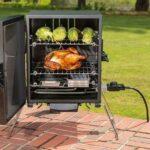To season a Blackstone griddle, first clean the griddle. Next, apply oil with a high smoke point, such as canola oil. Finally, heat the griddle until the oil starts to smoke.
But here’s a twist: your local climate can impact the seasoning process. 🌦️
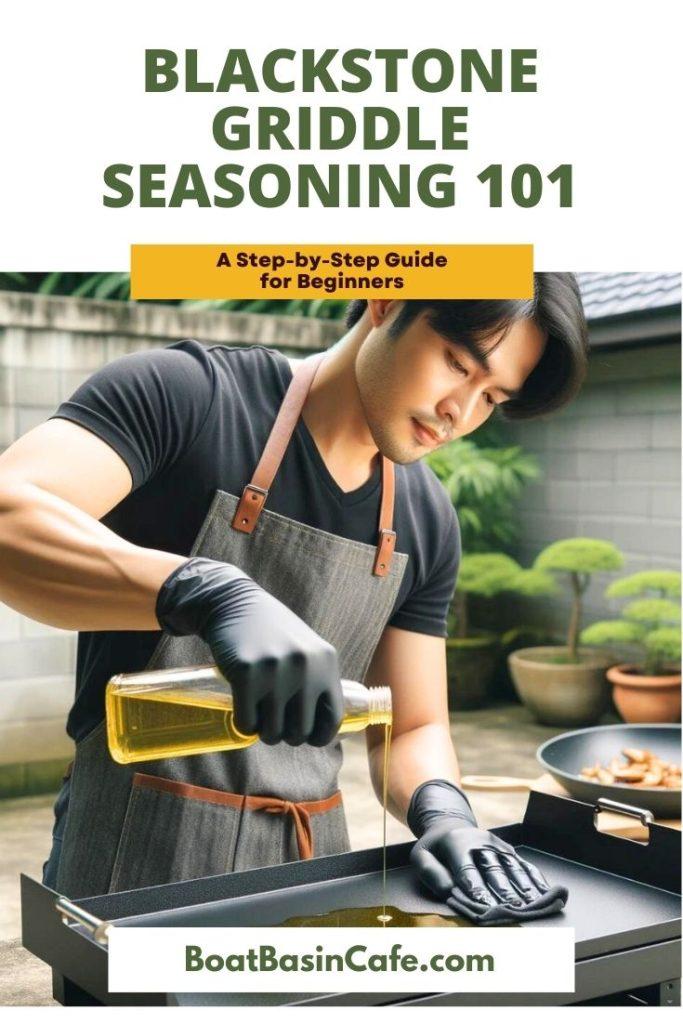
What is Seasoning?
👩🍳 Seasoning isn’t just for taste; it’s a vital part of griddle care. Through the Polymerization process, oil changes into a strong layer. Say goodbye to food sticking to the surface!
🔨 Necessary isn’t strong enough; a seasoned griddle becomes a reliable partner in your kitchen.
🛡 Beyond ease of cleaning and fighting off rust, seasoning adds years to your griddle’s life, making it important for long-term use.
| Process Step | What Happens | Importance |
|---|---|---|
| Breaking Down Oil | Fatty acids in the oil oxidize | Forms a new layer |
| Polymerization | The new layer binds together | Acts as a shield |
🍳 Each cooking session improves this shield. It’s like leveling up your griddle each time you use it.
🔥 Don’t forget proper seasoning does more than make tasks more manageable; it enhances your overall culinary adventure.
Why is Seasoning a Blackstone Griddle Important?
🥘 Griddle care begins with proper seasoning. Your griddle isn’t just another pan; it’s an investment.
👨🔧 Maintenance seasoning keeps the griddle in top shape. It’s not just about the first seasoning; it’s about keeping that layer robust.
🤑 Imagine saving money on costly replacements. Seasoning extends the life of the griddle, making it a financially wise choice.
🍳 Every dish comes out better on a seasoned griddle. From my days at Boat Basin Cafe, I can attest that a well-seasoned surface can make or break a dish.
Blackstone Grill Seasoning Basics and Tools

Materials and Tools Needed
📋 To get started on maintenance seasoning, gather these essentials.
- Blackstone griddle seasoning and cast iron conditioner: The cornerstone for a durable, non-stick surface.
- Warm water: Prepares the griddle surface for seasoning.
- Salt/mild soap: Ensures a clean start by removing existing residues.
- Towels and paper towels: Gets the griddle ready for oil application and ensures an even coating.
- Heat-resistant gloves: Safety first when handling the hot griddle.
- Crisco shortening or cooking oil: These oils and shortening have unique properties that make your seasoning stand out.
How to Season a Blackstone: Step-by-Step Guide
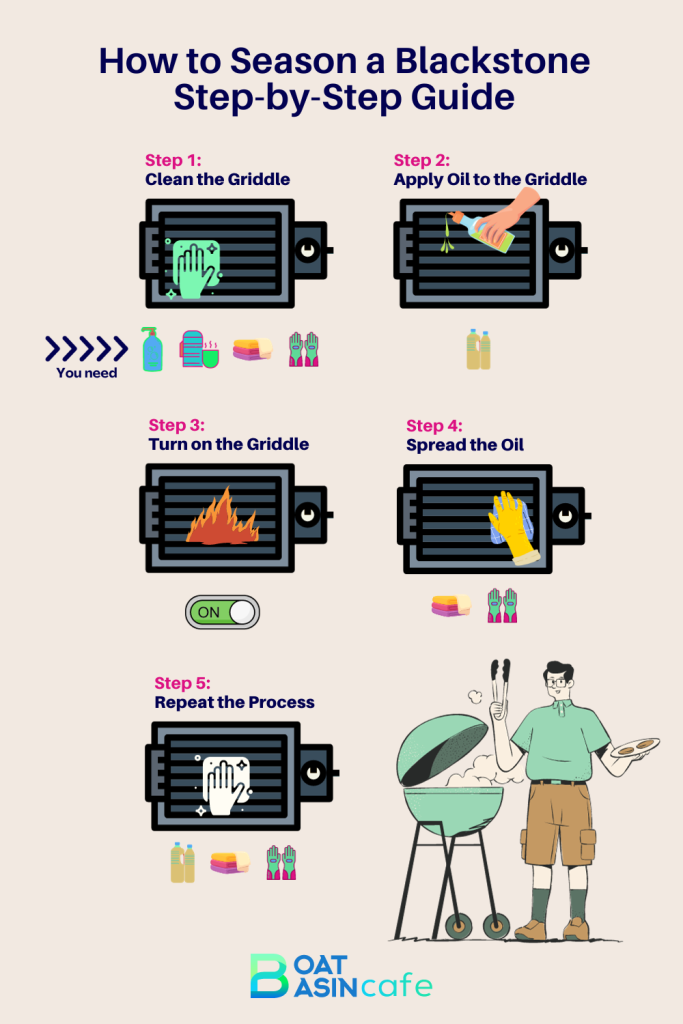
Step 1: Clean the Griddle
Make sure you start with a clean slate. Cleaning the griddle surface removes dirt and debris.
This step also preps the surface for better oil penetration. Use warm water and mild soap for a deep clean. Rinse and dry it fully. Why is this so crucial? A clean griddle is like a blank canvas for a painter—essential for the masterpiece to come.
Step 2: Apply Oil to the Griddle
Now comes the fun part—oiling the griddle. Apply a thin oil layer to the surface.
This creates a protective barrier. It prevents food from sticking and makes cleanup easier.
You may want to use high-smoke-point oils like canola or avocado oil. These oils handle high heat well. Propane griddles get extremely hot, so choosing the right oil is vital.
Step 3: Heat the Griddle
Turn on the griddle and crank up the heat.
This step helps you bond the oil to the griddle, forming a non-stick layer. Heat it for 15-20 minutes or until the oil smokes.
Ever noticed how a hot pan makes that sizzling sound when you add oil? That’s the sound of a good bond forming.
Step 4: Spread the Oil
With heat-resistant gloves, spread the oil evenly.
Avoid missing any spots to prevent hot spots on the griddle. A uniform layer is the goal here. The griddle’s heat works its magic, bonding the oil to the surface.
So, why gloves? Imagine trying to spread jelly on hot toast with bare hands. Not a good idea.
Step 5: Repeat the Process
Repeat steps 2-4 two or three more times.
The oil bonds more strongly each time. A black, glossy surface means success. It indicates a hard, durable layer that will last.
[su_note note_color=”#22CCCE”]Fact: Using overly thick layers of oil during seasoning can lead to chipping and a sticky surface.[/su_note]
Do these steps for Effective Flat Top Grill Seasoning. Clean the griddle after each use and store it in a dry, cool place.
This keeps the griddle in top shape for your next culinary adventure.
Best Oil to Season Griddle
So, what is the best oil to season a Blackstone griddle?
After much experimentation and trial, I recommend canola oil. It offers a solid balance of a high smoke point and neutral flavor, making it versatile for all kinds of cooking.
Canola oil is fascinating because it’s a Canadian invention—combining “Canada” and “ola,” meaning oil. It’s made from the seeds of a plant that’s a relative of the cabbage and turnip family. Not something you’d expect to be the cornerstone of your grilling, right?
Here’s a quick list of best oils for seasoning a Blackstone griddle:
- Canola Oil: High smoke point, neutral flavor
- Avocado Oil: High smoke point, slightly nutty flavor
- Grapeseed Oil: High smoke point, also neutral
What’s interesting is that the smoke point isn’t just a random number. It’s the temperature at which the oil starts to break down and produce smoke, losing its seasoning qualities. It’s a bit like the boiling point for water, but for oils.
[su_note note_color=”#22CCCE”]”Smoke Point” refers to the temperature at which an oil begins to produce visible smoke.[/su_note]
How Different Climates Can Affect Seasoning 🌦️
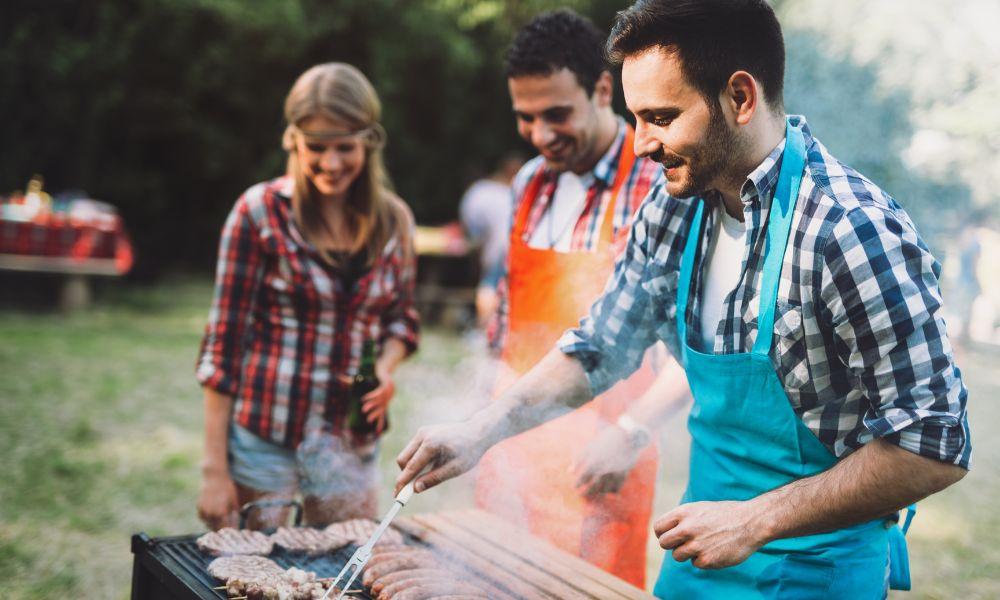
Humid Climates: The Moisture Challenge 🌧️
Humidity is an enemy of seasoning. Moist air can make it difficult for the oil to adhere properly to the griddle’s surface. The result? An inconsistent layer that might require more frequent touch-ups.
Dry Climates: The Heat Factor ☀️
In dry, hot conditions, the oil tends to dry quicker. While this sounds good, it can actually lead to an uneven seasoning layer if you’re not careful. Frequent checks during the process are key.
Cold Climates: Patience Required ❄️
Cold air can prolong the seasoning process. The oil takes longer to reach its smoking point, making it a test of patience to achieve that perfect non-stick surface.
Temperate Climates: The Ideal Condition? 🌤️
A moderate climate with low humidity is often considered ideal for seasoning. The oil adheres well, and you’re less likely to face the challenges posed by extreme conditions.
Troubleshooting Common Issues When Seasoning a Griddle
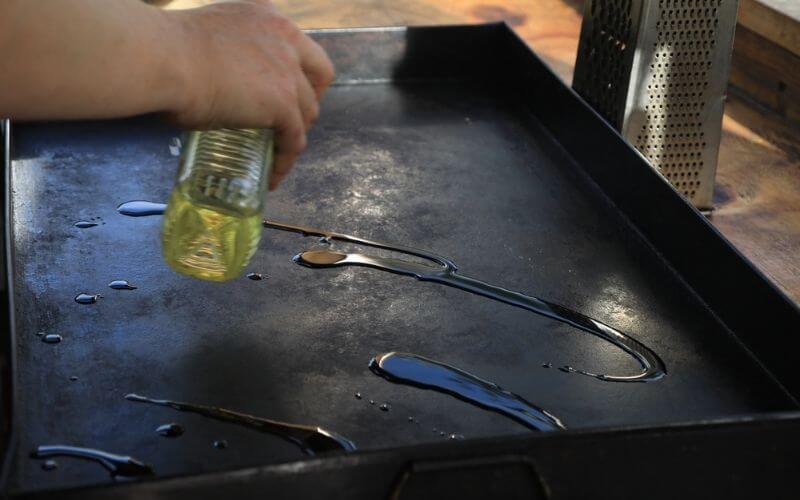
Seasoning a Blackstone griddle usually goes off without a hitch. But what about those times when things don’t go as planned? Here’s a quick troubleshooting guide to keep the seasoning process smooth.
Oil Is Not Sticking 🛑
Ever wipe oil on the griddle only to see it bead up and roll away? Oil Is Not Sticking to the surface can be frustrating. Ensure the griddle is spotless and bone-dry. High-smoke-point oils like canola are your friend here.
In fact, spreading the oil evenly with a cloth can make all the difference.
Excessive Smoking 💨
A little smoke is part of the game, but a smoke show means trouble. Excessive Smoking is often a heat issue. Dial down the heat and let the griddle catch its breath for a few minutes.
Lack of Black and Glossy Finish ✨
Hoping for that sleek black finish but ending up with something dull? Lack of Black and Glossy Finish often means the seasoning process isn’t complete. Multiple layers of oil and consistent heating can bring that sought-after sheen.
Rust Formation 🍂
Seeing orange? Rust Formation is a sign of neglect. A wire brush or scraper can remove rust spots. After that, a good seasoning session is in order. Keep the griddle clean and oiled to avoid future rust.
Long-term Griddle Care

So you’ve seasoned your griddle and are ready to take on the culinary world. But wait, the job isn’t over yet. Long-term care is a Must-have for any griddle owner. 🛠
Storage Tips 🌦
Outdoor griddles are especially susceptible to weather conditions. Store your griddle in a dry, cool place. If possible, invest in a quality cover for added protection against rain and snow. A covered griddle is like a parked car in a garage—safe and sound.
Cleaning: Less Is More 🧼
Contrary to popular belief, excessive scrubbing can do more harm than good. Mild soap and warm water usually do the trick. An interesting tip? Use coffee grounds as a natural abrasive for stubborn stains. Yes, the same coffee grounds that wake you up can wake up your griddle!
Routine Checks 📆
Mark your calendar for a monthly “Griddle Check-up.” Look for any signs of rust, warping, or wear and tear. Early detection of these issues can save you from bigger problems down the line. Think of it as a regular doctor’s visit but for your griddle.
Wondering when it’s time to re-season your griddle? Stay tuned; we’ll dive into that in a dedicated section coming up next. 📌
How Do You Know When to Re-season a Griddle? 🤔
Notice that sizzling steak isn’t sizzling anymore? It could be that the griddle isn’t pulling its weight. The most overlooked reason for this drop in performance is often the need for reseasoning.
🍳I once tried cooking eggs on an old griddle, only to find them sticking like glue. Lesson learned!
Signs It’s Time to Re-season 🚨
- Griddles speak: They show signs, not in words but in performance changes.
- The most common?: Food sticking to the surface is a red flag.
- Color Change: A once black and shiny griddle turning grey and ashy needs attention.
- Rust Spots: If you see these, your griddle is screaming for a reseasoning session.
Stick to a Schedule 🗓
Regular seasoning isn’t just an option; it’s a lifeline for your griddle. Consistency is key.
For example, if you grill on weekends, a bi-monthly seasoning keeps the surface in top shape. It’s like a spa day for your griddle but with oil instead of facemasks. 💆♂️
The Hidden Perks 🌟
Beyond the obvious need for a non-stick surface, regular seasoning also enhances the flavor of your food. Think of it as the griddle’s way of saying thank you, by making every dish a hit. 🥘
Common Mistakes to Avoid While Seasoning 🚫
Choosing Low Smoke Point Oils 🛢️
It’s tempting to reach for whatever oil is in the pantry, but not all oils are created equal for seasoning. High smoke point oils are essential. I once tried coconut oil; the result was less than ideal. Stick to canola or vegetable oil for a smooth seasoning process. Read more on
Impatience in the Process ⏳
A quick job won’t yield that non-stick griddle you’re aiming for. Time and patience are crucial. A rushed seasoning once led me to a griddle top that was anything but non-stick.
Neglecting the Initial Clean 🧼
The importance of starting with a clean griddle top can’t be overstated. I’ve seen a hasty seasoning over a dirty surface; the end result compromised the whole Blackstone griddle care process.
Inconsistent Heating 🔥
For effective flat top grill seasoning, a consistent medium-high heat across the steel griddle is key. Inconsistent temperatures can result in uneven seasoning, something I learned the hard way.
Overlooking After-Care 🧽
Seasoning isn’t the end. Regular care keeps your griddle in top shape. Skipping the after-care might not show immediate issues, but over time, it does add up. Keep it clean and dry for long-term happiness with your griddle.
Frequently Asked Questions (FAQs)
01. What Can You Cook on a Griddle?
Griddles are one of those versatile cooking surfaces that can do it all. From a simple grilled cheese with some scrambled eggs to seafood and burgers.
Having a flat top griddle like Blackstone opens so many opportunities. As the surface is very large, they are good for preparing party foods as you can cook 15+ burgers at the same time.
02. How Long Does It Take to Season a Blackstone Griddle?
Seasoning your griddle is not much work at all as all you have to do is sprinkle some oil and let it burn. But the whole process can be a bit time-consuming. Each seasoning layer takes 15-20 minutes to come to the smoke point.
You have to do multiple coatings of seasoning. Ideally, each griddle should have 4 coatings of seasoning to have a solid finish.
You can guess the whole thing can take a few hours to complete. So do this on a lazy Sunday afternoon with some cold beverages and snacks!
03. Can You Use Butter on a Blackstone Griddle?
Never use butter to season your griddle as it can not create the strong, durable coating we are looking for in a good seasoning. They are great to use while cooking but for the initial seasoning, use something with a high smoke point like canola oil.
04. Is a Blackstone Griddle Worth It?
If you are looking for a griddle, there really isn’t anything better than a Blackstone griddle. They are an industry classic for durability and functionality.
The sturdy construction makes them excellent to use on a regular basis. Most of the models come with rollers so moving around is not an issue either.
Yes, they are very prone to rusting as the whole thing is made with cold-rolled steel. But regular seasoning makes it feel almost non-stick.
Despite its huge size, the griddle gets hot very fast. So overall, Blackstone griddle is definitely worth every penny.
05. How often should I season my Blackstone griddle?
It’s recommended to season your griddle after every use, especially if you’re cooking with acidic or sugary foods that can damage the surface. Over time, you may need to re-season your griddle to maintain its non-stick properties.
06. Can I use butter to season my Blackstone griddle?
No, butter has a low smoke point and can burn quickly, leaving a sticky residue on the surface of the griddle. It’s best to use high smoke point oils like canola or vegetable oil for seasoning.
07. Can I use soap and water to clean my seasoned Blackstone griddle?
Yes, you can use soap and water to clean your griddle. Just be sure to rinse it thoroughly and dry it completely to prevent rust and other forms of damage.
08. What should I do if my Blackstone griddle starts to rust?
If you notice rust on your griddle, you can remove it by scrubbing the surface with a wire brush and then re-seasoning the griddle. To prevent rust in the future, be sure to clean and oil your griddle regularly and store it in a dry place.
Final Checklist for Seasoning Your Blackstone Griddle 📝
- Clean the Griddle: Remove all dirt and debris for an effective seasoning.
- Choose the Right Oil: High-smoke-point oils like canola or avocado are recommended.
- Apply a Thin Oil Layer: This forms the initial protective barrier.
- Heat the Griddle: 15-20 minutes or until the oil begins to smoke.
- Spread the Oil Evenly: Use heat-resistant gloves for safety.
- Check for a Glossy Finish: If not, repeat the process.
- Store Properly: Keep the griddle in a dry, cool place after use.
